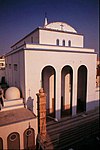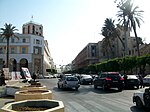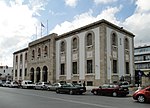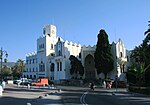Florestano Di Fausto
Florestano Di Fausto | |
|---|---|
 Florestano Di Fausto (c. 1930) | |
| Born | 16 July 1890 Rocca Canterano, Rome, Italy |
| Died | 11 January 1965 (aged 74) Rome, Italy |
| Nationality | Italian |
| Alma mater | Accademia di Belle Arti, Rome; Sapienza University of Rome, Rome |
| Occupation | Architect |
Florestano Di Fausto (16 July 1890 – 11 January 1965) was an Italian architect, engineer and politician who is best known for his building designs in the Italian
Early life and career

Born in
Rhodes and the Dodecanese

In 1923, Di Fausto started to work for the governor of the
Works in Italy and Albania

At the same time Di Fausto, whose prolificity was impressive, was continuing also his work in Italy, above all in Rome—where he owned a thriving studio—and surrounding regions, where, in the second half of the twenties, he designed several housing complexes: among them, those for the civil servants of the MAE, in Via delle tre Madonne, characterized by its Roman barocchetto style.
In the same period, he was active also in
Libya

In 1932, Di Fausto became "consultant for architecture" of the city of
Until the outbreak of World War II, Di Fausto extended his activity all over Libya, building hotels in pre-desertic towns as Jefren and Nalut, residences for officers in Tobruk, Menina and Castel Benito, various typologies of buildings in Benghazi, Misrata and Derna, and eight out of thirty-two rural villages, foundation towns for Italian colonists.[10] In all these works Di Fausto displayed his professional maturity, mastering the design of the most different types of buildings and design scales.[10] The peak of his African work was the design of the Libyan pavilion at the Mostra delle terre Italiane d'oltremare ("Exhibition of the Italian overseas territories") held in Naples in 1940.[10] His position as Balbo's "court architect" was sealed by the placement of his portrait near the Governor's in the frescoes painted by the Ferrarese Achille Funi on the vaults of the Church of Saint Francis in Tripoli, another work of him.[10]
In 1940, Di Fausto took also a short detour from his main activity, designing the scenography of the historic movie The King's Jester (Italian: Il re si diverte), directed by Mario Bonnard.[12]
Final years

During the war years, Di Fausto abandoned his fascist position approaching the
Legacy

Florestano Di Fausto was the most important Italian colonial architect of the Fascist regime.
In this context Di Fausto, who was not a rationalist, laid hands on this concept. In his only writing, published in 1937, he states: "Architecture was born in the Mediterranean and triumphed in Rome in the eternal monuments created from the genius of our birth: it must, therefore, remain Mediterranean and Italian."[17] His talent and his political connections allowed him to put this theorization into practice. Thanks to his many works in Albania, Libya, the Italian Aegean Islands and Italy itself, it has been defined "Architect of the Mediterranean" per antonomasia.[1] His adhesion to the concept of mediterraneità is also reflected by his steady necessity to come in contact with the Genius Loci of the places where he was going to operate: he wrote, in the same writing cited above: "Not a single stone was placed by me without having filled myself in advance with the spirit of the place, so as to make it my own".[14]
His work resulted in a continuous balancing between traditional and modern architecture, eclecticism and rationalism.[14] He was "an unsurpassed model of professional architect who, thanks to a remarkable preparation combined with consummate skills, was able to master, and to use indifferently, and in any geographical context, each possible style: from Moorish to Venetian Gothic, from Renaissance to Novecento, reducing even the rationalist language to another Modern Style."[18] Due to his steadily swinging between traditional and modern styles, he was unremittingly attacked by the two opposite fronts of colonialist architects, the "neoclassicists" and rationalists.[19] His work, long neglected after the war, has been rediscovered since the 1990s, and since then his legacy has more and more become the object of study, although a general catalog of his works is still missing.[13]
-
Al Waddan Center, Tripoli in the 1950s
-
Evangelismos church (former San Giovanni) at the Mandraki, Rhodes
-
Main post office, Rhodes
-
Girls' School, Rhodes, built with Andrea Torasso
-
Catholic church, Tripoli
-
Omar Mukhtar Street, Tripoli
-
Cesare Battisti Village, Libya
-
Gabriele D'Annunzio Village, Libya
-
Portico of the Palazzo del Governo, now Prefecture building, Rhodes
-
Grande albergo delle Rose, now Casino Rhodos, Rhodes, built with Michele Platania
-
Circolo Italia in Rhodes, now a pastry shop
-
Palazzo di Giustizia, now Courthouse, Rhodes, built with Rodolfo Petracco
-
Banca d'Italia building, now Bank of Greece, Rhodes
-
Palazzo del Governo, now Town Hall, Kos
See also
References
- ^ a b Di Marco (2011), p. 119
- ISBN 9788877945792.
- ^ a b c d e f g h i j k l m n o p q r s t u v w x y z aa ab ac ad ae Miano (1991)
- ^ a b c d e Di Marco (2011), p. 120
- ^ a b c d e f g Di Marco (2011), p. 122
- ^ Magalini, Chiara. "Predappio". www.emiliaromagna.beniculturali.it. MiBact. Retrieved 15 July 2014.
- ^ a b Di Marco (2011), p. 121
- ^ a b Di Marco (2011), p. 123
- ^ Di Marco (2011), p. 124
- ^ a b c d e f g h i Di Marco (2011), p. 125
- ^ Santoianni (2008), p. 59
- ^ "Il re si diverte". Cine Data Base. cinematografo.it. Retrieved 14 July 2014.
- ^ a b Di Marco (2011), p. 126
- ^ a b c d Santoianni (2008), p. 93
- ^ a b Santoianni (2008), p. 5
- ^ Santoianni (2008), p. 14
- ^ Anderson (2010), p. 3
- ^ Santoianni (2008), p. 86
- ^ Santoianni (2008), p. 96
Sources
- Di Fausto Florestano[permanent dead link]. Fascismo – Architettura – Arte / Arte fascista web site
- Giuseppe Miano (1991). "Florestano Di Fausto". Dizionario Biografico degli Italiani (in Italian). Enciclopedia Italiana. Retrieved 12 July 2014.
- Vittorio Santoianni (2008). "Il Razionalismo nelle colonie italiane 1928–1943. La "nuova architettura" delle Terre d'Oltremare" (PDF) (in Italian). Università degli Studi di Napoli "Federico II" – Facoltà di Architettura. Dipartimento di Progettazione Architettonica e Ambientale. Retrieved 12 July 2014.
- Sean Anderson (2010). "The Light and the Line: Florestano Di Fausto and the Politics of Mediterraneità". California Italian Studies. University of California. . Retrieved 12 July 2014.
- Di Marco, Fabrizio (2011). "Florestano Di Fausto, architetto del Mediterraneo". In Varagnoli, Claudio (ed.). Pescara senza rughe (in Italian). Roma: Gangemi. ISBN 9788849222128.














